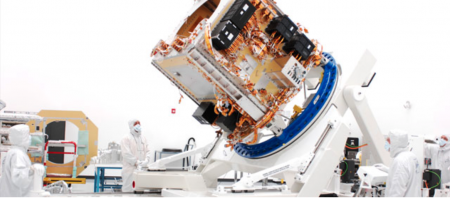Mission & Control
SPACEBEL is a recognized developer of IT systems for the ground segment to support both the mission operations and the user operations. The Mission & Control Business Unit is able to provide solutions covering almost all the aspects of the ground segment systems. Our background comprises several applications that are ultimately deployed to operational services.
For the Satellites Control Centres, the Mission & Control team has developed solutions especially for smallsat missions starting with the successful PROBA series (ESA). We develop turnkey systems or specific functions for the institutional and the Agencies core infrastructures. We also provide advanced and low-cost solutions for small missions and small constellations. Coupled with SPACEBEL satellite simulation framework, our systems can also be used in the context of space system Assembly Integration and Verification.
Operating a spacecraft such as a satellite implies the capability to plan and schedule the platform and the payload activity. This is one of the main functions developed by SPACEBEL and delivered to CNES and ESA Missions Operations Centres for Earth Observation and Telecom missions. Thanks to a strong background in automation and mission planning technology, solutions are built on top of a generic in-house software which is designed to meet specific customer requirements. They can be complemented by satellite simulations, optimization software and artificial intelligence tools.
The Payload Data Ground Segment features several functionalities i.a. the Mission Planning, the acquisition, the processing, the calibration and the archiving of the payload data. It also creates the relevant catalogue and distributes on demand the resulting science or imaging data. SPACEBEL develops and deploys operational systems implementing such functionalities or the whole PDGS as a standalone facility.
Still making part of the Ground Data Systems, SPACEBEL develops instrument simulators and provides solutions for the processing of the instrument data. Our main achievements in the domain of Ground Prototype Processors and Instrument Data Simulators are related to applications in the field of Earth Observation namely radar, spectrometry and radiometry technology. These processors are used for the sake of the mission or to evaluate the performance of the instrument. They may be used as is to support the instrument development or they may be integrated after industrialization in the Payload Data Ground Processing Centres.
Reference Projects
- PROBA Control Centres
SPACEBEL has developed all satellite control centres for the PROBA missions of ESA. PROBA 2, sun observation mission and the global PROBA V Earth Observation mission dedicated to Vegetation still operate in orbit. The development of PROBA 3, formation flying mission composed by 2 spacecraft and PROBA Altius, dedicated to the daily analysis of the atmospheric ozone is well advanced. The systems operated from ESEC an ESA facility in Belgium are largely automated so as to enable unsupervised passes with automatic uplink of telecommands, telemetry reception and processing and products distribution.
- ALTIUS PDGS
SPACEBEL develops the Payload Data Ground System for the PROBA Altius spacecraft. The mission aims to provide a global composition of the atmospheric limb, resulting in the provision of atmospheric ozone as main product and aerosols, azote dioxide as secondary products. The system distributes the processed data 3 hours after their capture by the satellite. SPACEBEL leads an international consortium composed of science and industry partners including the Institute for Space Aeronomy (Belgium) and the University of Saskatchewan (CAN). It will be operated from the B-USOC in Belgium.
- ESA Common Software Infrastructure
SPACEBEL is a key player in the transition of ESA Space Systems Monitoring and Control infrastructure. The company make part of the industrial team in charge of the development of the new European Ground Systems Common Core (EGS-CC) and recently realised the first adaption of it to small missions. SPACEBEL now contributes the development of a deployment model for the future mission Mission & Control infrastructures taking advantage of the share of resources and scalability of architectures.
- Hera CMOC
SPACEBEL is in charge of Hera’s Cubesat Mission Operations Centre (CMOC) development. Located in Redu (Belgium), it will oversee mission operations and control the European Milani and Juventas cubesat duo. Its role: manage mission requests, flight dynamics, telemetry and data exchange between the main spacecraft and its bread-box sized cubesats.
The purpose of the latter is twofold:
· collect more detailed scientific data on the Dimorphos asteroid and its environment in order to gain a better understanding of the structure and composition of asteroids
· evaluate novel inter-satellite link technology and demonstrate cubesat technology use in a deep-space environment.
Juventas will perform radar soundings whereas Milani will scan the celestial bodies in a wider range of colours than the human eye can see thanks to its hyperspectral imager.
Technologies & Skills
SPACEBEL contribute to the advanced system and mission operation concepts by performing studies, technology investigations and prototyping related to the implementation and validation of new subsystems and tools. The current technology shift from standalone monolithic software to cloud-based micro-services architecture is one exciting example and the Mission & Control engineering team of SPACEBEL take part in it. Among the leading-edge R&D activities performed internally, we refer to the following objectives:
- Migrating control centre software from a monolithic application that can monitor and control a single satellite to a micro-services system that can handle a whole constellation of satellites
- Developing Cloud native applications using container and cloud orchestration technologies
- Promoting the use of Web applications
- Offering control centre-as-a-service solutions
- Deploying building blocks for advanced automation by integrating machine learning, optimization problems and artificial intelligence techniques
- Securing the dependability and cyber-security of operation systems

ESA Common Software Infrastructure
